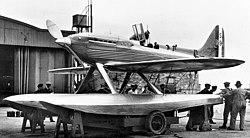Supermarine p.6B
| Supermarine p.6B | |
|---|---|

|
|
| Type: | Seaplane |
| Design country: | |
| Manufacturer: | |
| First flight: |
July 29, 1931 |
| Commissioning: |
1931 |
| Number of pieces: |
2 |
The Supermarine S.6B was a British seaplane designed to take part in the Schneider Trophy .
history
It was developed in two copies by the designer Reginald Joseph Mitchell of the aircraft manufacturer Supermarine ( S1595and S1596). The S.6B was a further development of the Supermarine S.6 with a reinforced cell , enlarged floats and a significantly more powerful engine.
The competition took place on September 13, 1931 at Calshot Spit ( Southampton Water , UK ). One of the two S.6Bs that S1595took part in the race was the only aircraft, so it was enough to fly off the route to achieve first place. The pilot, Flight Lieutenant HRD John Boothman , achieved an average speed of 547.31 km / h - the highest so far at the Schneider Trophy. With the three-time victory of a British aircraft, the competition rules according to the Schneider Cup finally went to Great Britain.
On September 9, 1931, the pilot Flight Lieutenant HRD GH Stainforth flew 655.8 km / h (407.5 mph) with the same machine and an engine boosted to 2550 hp, the world record for airplanes at that time.
The knowledge gained during the construction of the Supermarine S.6B ultimately led to the development of the Supermarine Spitfire with its Rolls-Royce-Merlin engine .
construction
The Supermarine S.6B was a single-seater in low-wing construction made of all-metal with fabric-covered oars and two floats . These served at the same time to take up the fuel, most of which was housed in the right float, in order to compensate for the strong torque of the propeller with its mass . There were weights in the tips of the floats for stabilization. The coolant container for the oil was located in the fin of the vertical stabilizer together with the upstream false keel on the top of the fuselage. Between the oil tank and the engine, there were five tubes on each side of the fuselage as well as on the underside of the fuselage, which transported the oil to the engine and back again and at the same time, while lying in the airstream, ensured its cooling.
The wing of the S.6B had two spars and was double-clad. A cooling water circuit was located between the two layers, which in turn was cooled by air fed into the interior of the wing. The surface of the float was also used for cooling.
Technical specifications
| Parameter | Data |
|---|---|
| crew | 1 |
| length | 8.78 m |
| span | 9.14 m |
| height | 3.73 m |
| Takeoff mass | 2761 kg |
| Top speed | 656 km / h |
| Engine | a Rolls-Royce R , 12 cylinders in V-arrangement, 2,350 PS (approx. 1,730 kW), later 2,550 PS (approx. 1,880 kW) |
See also
literature
- CF Andrews, EB Morgan: Supermarine Aircraft since 1914. Putnam, London 1987, ISBN 0-85177-800-3 .
- William Green (Ed.): Supermarine's Schneider Seaplanes. In: Flying Review International. Volume 10, No. July 11, 1967.
- Jim Winchester: Supermarine p.6B. In: Concept Aircraft. Prototypes, X-Planes and Experimental Aircraft. Grange Books plc., Kent 2005, ISBN 978-1-84013-809-2 .
Web links
- Supermarine S6 and S6B. Winner of the 1929 and 1931 Schneider Trophy contests, securing the Schneider Trophy for Britain. In: Heritage. BAE Systems , accessed on November 17, 2019 (English, manufacturer's website).
- Photo of pilot JN Boothman and the S.6B on www.hydroretro.net
- Detailed photos of the S.6B
Individual evidence
- ↑ a b Airplanes in their time: Supermarine, p.6B. In: Aerosport No. 5/1966, pp. 177/178
- ^ Page Royal Air Force - The Inter-War Years (English, PDF; 623 kB) ( Memento of October 12, 2011 in the Internet Archive )
